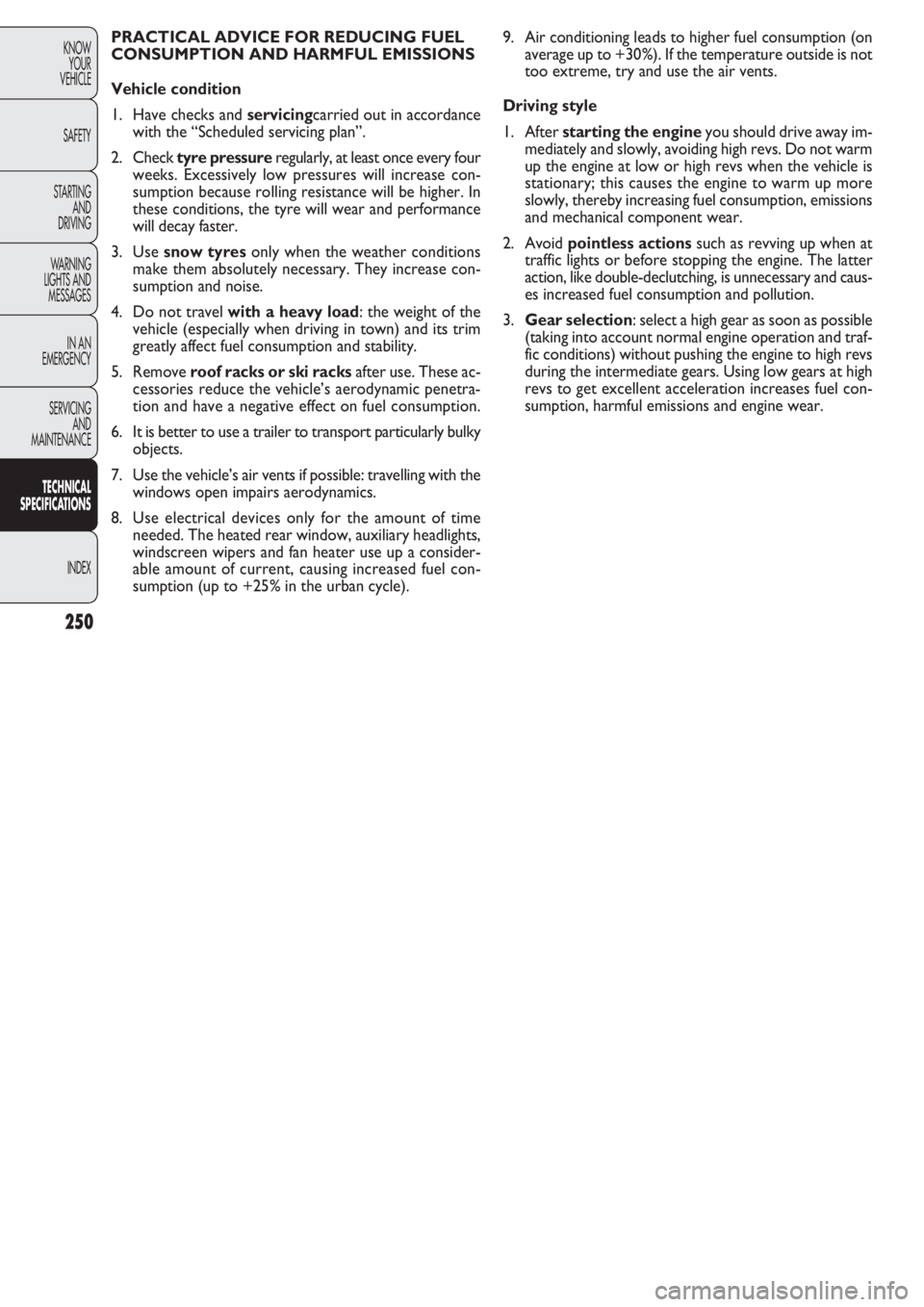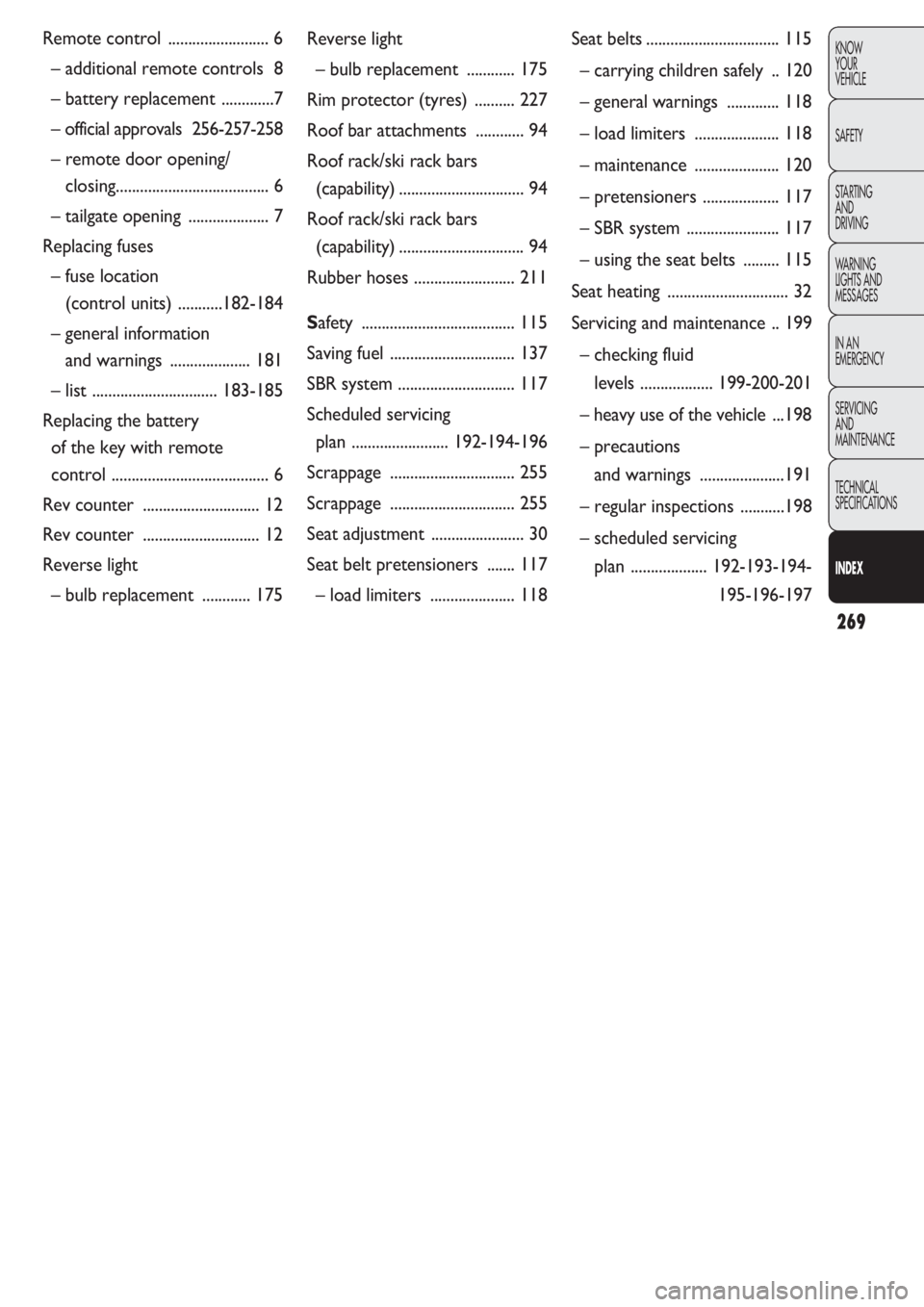maintenance schedule FIAT DOBLO COMBI 2011 Owner handbook (in English)
[x] Cancel search | Manufacturer: FIAT, Model Year: 2011, Model line: DOBLO COMBI, Model: FIAT DOBLO COMBI 2011Pages: 274, PDF Size: 5.96 MB
Page 251 of 274

250
KNOW
YOUR
VEHICLE
SAFETY
STARTING
AND
DRIVING
WARNING
LIGHTS AND
MESSAGES
IN AN
EMERGENCY
SERVICING
AND
MAINTENANCE
TECHNICAL
SPECIFICATIONS
INDEX
9. Air conditioning leads to higher fuel consumption (on
average up to +30%). If the temperature outside is not
too extreme, try and use the air vents.
Driving style
1. After starting the engineyou should drive away im-
mediately and slowly, avoiding high revs. Do not warm
up the engine at low or high revs when the vehicle is
stationary; this causes the engine to warm up more
slowly, thereby increasing fuel consumption, emissions
and mechanical component wear.
2. Avoid pointless actions such as revving up when at
traffic lights or before stopping the engine. The latter
action, like double-declutching, is unnecessary and caus-
es increased fuel consumption and pollution.
3.Gear selection: select a high gear as soon as possible
(taking into account normal engine operation and traf-
fic conditions) without pushing the engine to high revs
during the intermediate gears. Using low gears at high
revs to get excellent acceleration increases fuel con-
sumption, harmful emissions and engine wear. PRACTICAL ADVICE FOR REDUCING FUEL
CONSUMPTION AND HARMFUL EMISSIONS
Vehicle condition
1. Have checks and servicingcarried out in accordance
with the “Scheduled servicing plan”.
2. Check tyre pressure regularly, at least once every four
weeks. Excessively low pressures will increase con-
sumption because rolling resistance will be higher. In
these conditions, the tyre will wear and performance
will decay faster.
3. Use snow tyresonly when the weather conditions
make them absolutely necessary. They increase con-
sumption and noise.
4. Do not travel with a heavy load: the weight of the
vehicle (especially when driving in town) and its trim
greatly affect fuel consumption and stability.
5. Remove roof racks or ski racksafter use. These ac-
cessories reduce the vehicle’s aerodynamic penetra-
tion and have a negative effect on fuel consumption.
6. It is better to use a trailer to transport particularly bulky
objects.
7. Use the vehicle’s air vents if possible: travelling with the
windows open impairs aerodynamics.
8. Use electrical devices only for the amount of time
needed. The heated rear window, auxiliary headlights,
windscreen wipers and fan heater use up a consider-
able amount of current, causing increased fuel con-
sumption (up to +25% in the urban cycle).
Page 270 of 274

269
KNOW
YOUR
VEHICLE
SAFETY
STARTING
AND
DRIVING
WARNING
LIGHTS AND
MESSAGES
IN AN
EMERGENCY
SERVICING
AND
MAINTENANCE
TECHNICAL
SPECIFICATIONS
INDEX
Remote control ......................... 6
– additional remote controls 8
– battery replacement .............7
– official approvals 256-257-258
– remote door opening/
closing...................................... 6
– tailgate opening .................... 7
Replacing fuses
– fuse location
(control units) ...........182-184
– general information
and warnings .................... 181
– list ...............................183-185
Replacing the battery
of the key with remote
control ....................................... 6
Rev counter ............................. 12
Rev counter ............................. 12
Reverse light
– bulb replacement ............ 175Reverse light
– bulb replacement ............ 175
Rim protector (tyres) .......... 227
Roof bar attachments ............ 94
Roof rack/ski rack bars
(capability)............................... 94
Roof rack/ski rack bars
(capability)............................... 94
Rubber hoses ......................... 211
Safety ...................................... 115
Saving fuel ............................... 137
SBR system ............................. 117
Scheduled servicing
plan ........................192-194-196
Scrappage ............................... 255
Scrappage ............................... 255
Seat adjustment ....................... 30
Seat belt pretensioners ....... 117
– load limiters ..................... 118Seat belts................................. 115
– carrying children safely .. 120
– general warnings ............. 118
– load limiters ..................... 118
– maintenance ..................... 120
– pretensioners ................... 117
– SBR system ....................... 117
– using the seat belts ......... 115
Seat heating .............................. 32
Servicing and maintenance .. 199
– checking fluid
levels ..................199-200-201
– heavy use of the vehicle...198
– precautions
and warnings .....................191
– regular inspections ...........198
– scheduled servicing
plan ...................192-193-194-
195-196-197